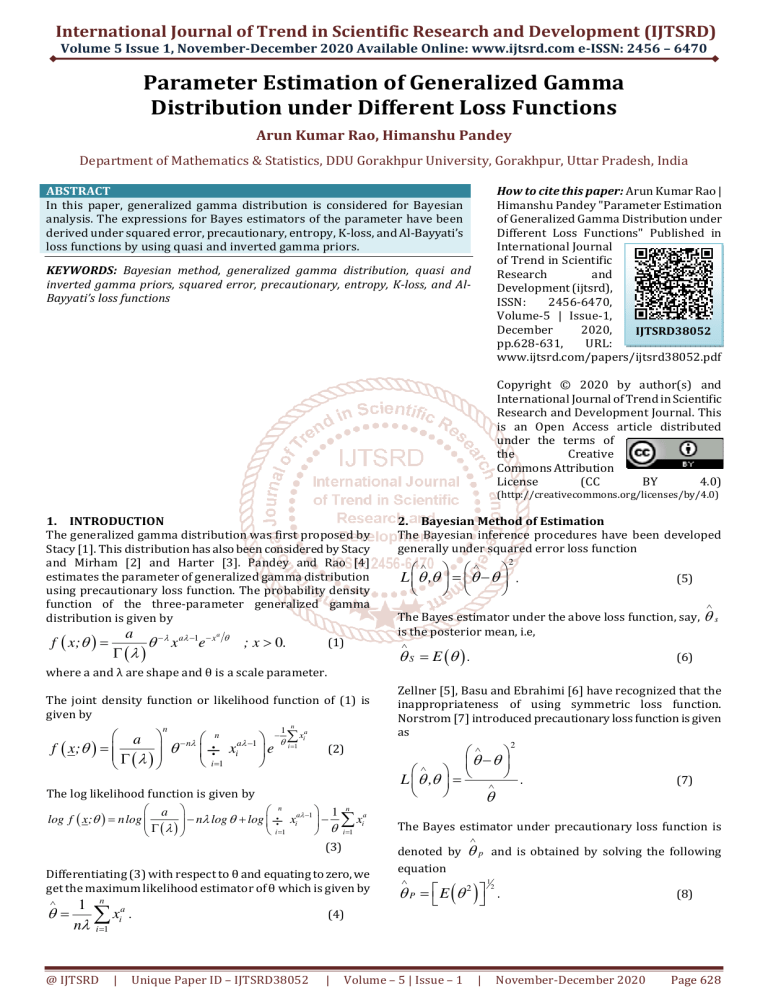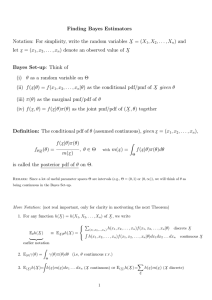
International Journal of Trend in Scientific Research and Development (IJTSRD)
Volume 5 Issue 1, November-December 2020 Available Online: www.ijtsrd.com e-ISSN: 2456 – 6470
Parameter Estimation of Generalized Gamma
Distribution under Different Loss Functions
Arun Kumar Rao, Himanshu Pandey
Department of Mathematics & Statistics, DDU Gorakhpur University, Gorakhpur, Uttar Pradesh, India
How to cite this paper: Arun Kumar Rao |
Himanshu Pandey "Parameter Estimation
of Generalized Gamma Distribution under
Different Loss Functions" Published in
International Journal
of Trend in Scientific
Research
and
Development (ijtsrd),
ISSN:
2456-6470,
Volume-5 | Issue-1,
December
2020,
IJTSRD38052
pp.628-631,
URL:
www.ijtsrd.com/papers/ijtsrd38052.pdf
ABSTRACT
In this paper, generalized gamma distribution is considered for Bayesian
analysis. The expressions for Bayes estimators of the parameter have been
derived under squared error, precautionary, entropy, K-loss, and Al-Bayyati’s
loss functions by using quasi and inverted gamma priors.
KEYWORDS: Bayesian method, generalized gamma distribution, quasi and
inverted gamma priors, squared error, precautionary, entropy, K-loss, and AlBayyati’s loss functions
Copyright © 2020 by author(s) and
International Journal of Trend in Scientific
Research and Development Journal. This
is an Open Access article distributed
under the terms of
the
Creative
Commons Attribution
License
(CC
BY
4.0)
(http://creativecommons.org/licenses/by/4.0)
1. INTRODUCTION
The generalized gamma distribution was first proposed by
Stacy [1]. This distribution has also been considered by Stacy
and Mirham [2] and Harter [3]. Pandey and Rao [4]
estimates the parameter of generalized gamma distribution
using precautionary loss function. The probability density
function of the three-parameter generalized gamma
distribution is given by
f ( x;θ ) =
a
Γ (λ )
θ − λ x aλ −1e − x
a
θ
; x > 0.
(1)
2. Bayesian Method of Estimation
The Bayesian inference procedures have been developed
generally under squared error loss function
2
∧ ∧
L θ ,θ = θ − θ .
(5)
∧
The Bayes estimator under the above loss function, say, θ s
is the posterior mean, i.e,
∧
θ S = E (θ ) .
(6)
where a and λ are shape and θ is a scale parameter.
The joint density function or likelihood function of (1) is
given by
n
1
n
xia
a − nλ n aλ −1 −θ ∑
i =1
f ( x;θ ) =
θ ∏ xi e
i =1
Γ (λ )
(2)
The log likelihood function is given by
a
n aλ −1 1 n a
log f ( x;θ ) = nlog
− nλ log θ + log ∏ xi − ∑ xi
i =1
θ i =1
Γ (λ )
(3)
Differentiating (3) with respect to θ and equating to zero, we
get the maximum likelihood estimator of θ which is given by
∧
n
1
θ = ∑ xia .
nλ i =1
(4)
@ IJTSRD
|
|
Unique Paper ID – IJTSRD38052
Zellner [5], Basu and Ebrahimi [6] have recognized that the
inappropriateness of using symmetric loss function.
Norstrom [7] introduced precautionary loss function is given
as
2
∧
θ − θ
∧
.
L θ ,θ =
∧
θ
(7)
The Bayes estimator under precautionary loss function is
∧
denoted by
equation
θp
∧
θ P = E (θ 2 )
Volume – 5 | Issue – 1
|
and is obtained by solving the following
1
2
.
November-December 2020
(8)
Page 628
International Journal of Trend in Scientific Research and Development (IJTSRD) @ www.ijtsrd.com eISSN: 2456-6470
In many practical situations, it appears to be more realistic
∧
to express the loss in terms of the ratio
θ
θ
. In this case,
Calabria and Pulcini [8] points out that a useful asymmetric
loss function is the entropy loss
L (δ ) ∝ δ − p log e ( δ ) − 1
(ii) Inverted gamma prior: Generally, the inverted gamma
density is used as prior distribution of the parameter θ given
by
g 2 (θ ) =
p
β α −(α +1) − β θ
θ
e
; θ > 0.
Γ (α )
∧
∧
θ
where δ = , and whose minimum occurs at θ = θ . Also,
θ
the loss function L (δ ) has been used in Dey et al. [9] and
Dey and Liu [10], in the original form having
L (δ ) can written be as
3. Posterior density under
given by
n
∧
θE
and is obtained by solving the following equation
−1
1
θ E = E .
θ
∧
(10)
Wasan [11] proposed the K-loss function which is given as
2
∧
(11)
Under K-loss function the Bayes estimator of θ is denoted by
∧
∧
E (θ )
.
E (1 θ )
2
(13)
Under Al-Bayyati’s loss function the Bayes estimator of θ is
∧
∧
and is obtained as
( ).
E (θ )
E θ
−( nλ + d )
e
−
e
n
1
θ∑
i =1
xia
n
1
xia
θ∑
i =1
dθ
0
n a
n
1
∑ xi
− ∑ xia
θ
= i =1
θ −( nλ + d ) e i =1
Γ ( nλ + d − 1)
(17)
Theorem 1 On using (17), we have
c
Γ ( nλ + d − c − 1) n a
=
∑ xi
Γ ( nλ + d − 1) i =1
c
(18)
Proof. By definition,
∧
∧
L θ ,θ = θ c θ − θ .
θ Al =
∫θ
n
(12)
Al-Bayyati [12] introduced a new loss function using Weibull
distribution which is given as
θ Al
∞
E θ
1
2
denoted by
θ
−
− ( nλ + d )
( )
and is obtained as
θK =
=
1
nλ + d −1
θ − θ
∧
L θ ,θ = ∧ .
θθ
θK
n
xia
a − nλ n aλ −1 −θ ∑
i =1
xi e
θ − d dθ
∫0 Γ ( λ ) θ ∏
i =1
∞
The Bayes estimator under entropy loss function is denoted
by
n
1
xia
a − nλ n aλ −1 −θ ∑
i =1
θ
x
e
θ −d
∏
i
i =1
Γ (λ )
f (θ x ) =
(9)
g1 (θ )
The posterior density of θ under g1 (θ ) , on using (2), is
p = 1. Thus
L (δ ) = b δ − log e (δ ) − 1 ; b>0.
(16)
c +1
c
(14)
( )
E θ c = ∫ θ c f (θ x ) dθ
nλ + d −1
n a
n
1
∑ xi
∞
− ∑ xia
θ i =1
− ( nλ + d − c )
i =1
=
θ
e
dθ
Γ ( nλ + d − 1) ∫0
nλ + d −1
n a
∑ xi
Γ ( nλ + d − c − 1)
= i =1
Γ ( nλ + d − 1) n a nλ + d −c −1
∑ xi
i =1
Γ ( nλ + d − c − 1) n a
=
∑ xi .
Γ ( nλ + d − 1) i =1
c
Let us consider two prior distributions of θ to obtain the
Bayes estimators.
(i) Quasi-prior: For the situation where we have no prior
information about the parameter θ, we may use the quasi
density as given by
g1 (θ ) =
1
θ
d
; θ > 0, d ≥ 0,
(15)
where d = 0 leads to a diffuse prior and d = 1, a noninformative prior.
@ IJTSRD
|
Unique Paper ID – IJTSRD38052
|
From equation (18), for
c = 1 , we have
n
E (θ ) =
∑x
i =1
a
i
(19)
nλ + d − 2
From equation (18), for
Volume – 5 | Issue – 1
|
c = 2 , we have
November-December 2020
Page 629
International Journal of Trend in Scientific Research and Development (IJTSRD) @ www.ijtsrd.com eISSN: 2456-6470
2
( )
E θ2
n a
∑ xi
i =1
=
( nλ + d − 2 )( nλ + d − 3)
From equation (18), for
1 nλ + d − 1
E = n
θ
xa
∑
(
c = −1 , we have
(22)
∑ xia
i =1
(23)
nλ + d − 2
From equation (8), on using (20), the Bayes estimator of θ
under precautionary loss function is given by
∧
n
− 12
θ P = ( nλ + d − 2 )( nλ + d − 3 )
∑x
a
i
i =1
(24)
From equation (10), on using (21), the Bayes estimator of θ
under entropy loss function is given by
n
θE =
∑x
a
i
i =1
dθ
θ −( nλ +α +1) e
=
n
1
− β + xia
θ
i =1
∑
n
β
xia
+
∑
i =1
nλ +α
n
β
+
xia
∑
i =1
=
Γ ( nλ + α )
θ −( nλ +α +1) e
n
1
− β + xia
θ i =1
∑
(28)
g1 (θ )
n
∧
e
nλ +α
c +1
From equation (6), on using (19), the Bayes estimator of θ
under squared error loss function is given by
∧
∑
− ( nλ +α +1)
c = c + 1 , we have
4. Bayes Estimators under
θS =
n
1
− β + xia
θ
i =1
Γ ( nλ + α )
Γ ( nλ + d − c − 2 ) n a
=
∑ xi
Γ ( nλ + d − 1) i =1
)
∞
∑
0
(21)
From equation (18), for
E θ
=
∫θ
i
i =1
c +1
(20)
θ −( nλ +α +1) e
n
1
− β + xia
θ i =1
Theorem 2. On using (28), we have
( )
E θ
c
n
Γ ( nλ + α − c )
β
=
+
xia
∑
Γ ( nλ + α )
i =1
(29)
Proof. By definition,
( )
E θ c = ∫ θ c f (θ x ) dθ
nλ +α
n
β
+
xia
∑
i =1
=
Γ ( nλ + α )
∞
∫0 θ
− ( nλ +α +1− c )
n
1
− β + xia
θ
i =1
∑
e
dθ
nλ +α
n
β
+
xia
∑
i =1
=
Γ ( nλ + α )
Γ ( nλ + α − c )
n
xia
+
β
∑
i =1
(25)
nλ + d − 1
c
nλ +α − c
n
Γ ( nλ + α − c )
=
+
xia .
β
∑
Γ ( nλ + α )
i =1
c
From equation (12), on using (19) and (21), the Bayes
estimator of θ under K-loss function is given by
∧
θ K = ( nλ + d − 2 )( nλ + d − 1)
− 12
n
∑x
i =1
a
i
(26)
From equation (29), for
From equation (14), on using (18) and (22), the Bayes
estimator of θ under Al-Bayyati’s loss function is given by
E (θ ) =
n
∑x
∧
θ Al =
i =1
a
i
nλ + d − c − 2
.
(27)
5. Posterior density under
Under
g 2 (θ )
g 2 (θ ) , the posterior density of θ, using equation
(2), is obtained as
f (θ x ) =
n
1
xia
a − nλ
β α −(α +1) − β θ
θ∑
aλ −1
i =1
θ
θ
x
e
e
∏
i
Γ (α )
i =1
Γ (λ )
n
n
−
1
n
xi
a − nλ n aλ −1 −θ ∑
β α −(α +1) − β θ
xi e i =1
θ
e dθ
∫0 Γ ( λ ) θ ∏
Γ (α )
i =1
∞
β + ∑ xia
i =1
a
From equation (29), for
|
Unique Paper ID – IJTSRD38052
|
c = 2 , we have
2
( )
E θ2
n
β
+
xia
∑
i =1
=
( nλ + α − 1)( nλ + α − 2 )
nλ + α
1
E =
n
θ β + xa
∑i
(31)
c = −1 , we have
(32)
i =1
From equation (29), for
@ IJTSRD
(30)
nλ + α − 1
From equation (29), for
n
c = 1 , we have
n
Volume – 5 | Issue – 1
|
c = c + 1 , we have
November-December 2020
Page 630
International Journal of Trend in Scientific Research and Development (IJTSRD) @ www.ijtsrd.com eISSN: 2456-6470
(
E θ
c +1
)
n
Γ ( nλ + α − c − 1)
β
xia
=
+
∑
Γ ( nλ + α )
i =1
6. Bayes Estimators under
c +1
(33)
above equation, it is clear that the Bayes estimators depend
upon the parameters of the prior distribution.
References
[1] Stacy, E.W., (1962): “A generalization of the gamma
distribution”. Ann. Math. Statist, 33, 1187-1192.
g 2 (θ )
From equation (6), on using (30), the Bayes estimator of θ
under squared error loss function is given by
[2]
Stacy, E. W. and Mirham, G. A. (1965): “Parameter
estimation for a generalized gamma distribution”.
Techno metrics 7, 349-358.
[3]
Harter, H. L., (1967): “Maximum likelihood estimation
of the parameter of a generalized gamma population
from complete and censored samples”. Techno
metrics 9, 159-165.
[4]
Pandey, H. and Rao, A. K., (2006): “Bayesian
estimation of scale parameter of generalized gamma
distribution using precautionary loss function”.
Indian J. Appl. Statistics, 10, 21-27.
[5]
Zellner, A., (1986): “Bayesian estimation and
prediction using asymmetric loss functions”. Jour.
Amer. Stat. Assoc., 91, 446-451.
[6]
Basu, A. P. and Ebrahimi, N., (1991): “Bayesian
approach to life testing and reliability estimation
using asymmetric loss function”. Jour. Stat. Plann.
Infer, 29, 21-31.
[7]
Norstrom, J. G., (1996): “The use of precautionary loss
functions in Risk Analysis”. IEEE Trans. Reliab., 45(3),
400-403.
[8]
Calabria, R., and Pulcini, G. (1994): “Point estimation
under asymmetric loss functions for left truncated
exponential samples”. Comm. Statist. Theory &
Methods, 25 (3), 585-600.
[9]
D. K. Dey, M. Ghosh and C. Srinivasan (1987):
“Simultaneous estimation of parameters under
entropy loss”. Jour. Statist. Plan. And infer, 347-363.
[10]
D. K. Dey, and Pei-San Liao Liu (1992): “On
comparison of estimators in a generalized life Model”.
Microelectron. Reliab. 32 (1/2), 207-221.
[11]
Wasan, M. T., (1970): “Parametric Estimation”. New
York: Mcgraw-Hill.
[12]
Al-Bayyati, (2002): “Comparing methods of
estimating Weibull failure models using simulation”.
Ph.D. Thesis, College of Administration and
Economics, Baghdad University, Iraq.
n
∧
θS =
β + ∑ xia
i =1
(34)
nλ + α − 1
From equation (8), on using (31), the Bayes estimator of θ
under precautionary loss function is given by
θ P = ( nλ + α − 1)( nλ + α − 2 ) β + ∑ xia (35)
i =1
∧
− 12
n
From equation (10), on using (32), the Bayes estimator of θ
under entropy loss function is given by
n
∧
θE =
β + ∑ xia
i =1
(36)
nλ + α
From equation (12), on using (30) and (32), the Bayes
estimator of θ under K-loss function is given by
n
∧
−1
θ K = ( nλ + α − 1)( nλ + α ) 2 β + ∑ xia
i =1
(37)
From equation (14), on using (29) and (33), the Bayes
estimator of θ under Al-Bayyati’s loss function is given by
n
∧
θ Al =
β + ∑ xia
i =1
nλ + α − c − 1
.
(38)
Conclusion
In this paper, we have obtained a number of estimators of
parameter of generalized gamma distribution. In equation
(4) we have obtained the maximum likelihood estimator of
the parameter. In equation (23), (24), (25), (26) and (27) we
have obtained the Bayes estimators under different loss
functions using quasi prior. In equation (34), (35), (36), (37)
and (38) we have obtained the Bayes estimators under
different loss functions using inverted gamma prior. In the
@ IJTSRD
|
Unique Paper ID – IJTSRD38052
|
Volume – 5 | Issue – 1
|
November-December 2020
Page 631






